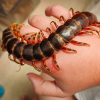To my understanding, Camponotus us-ca02 (no common name) has remained undescribed because it was belived that a journal from Mexico was describing them. However, it never came to fruition. There has been numerous specimens collected of the species, I have no clue to an idea how only three specimens were found on AntWeb when more than that are imaged. It should also be noted that there is multiple morphotaxons on antweb for C. us-ca02 as well and they are as follows: us-ca02, us_ca02, bca02, and semitestaceus_cf. There is plenty enough research done on the species to describe them, which Dr. Phil Ward currently is working on. "Well-loved" is a stretch, since that is strictly a hobbyist love and not a myrmecologist thing. It takes time and effort to procure specimens, examine specimens, described, and distinguish/diagnose them - let alone the cost it takes to do that on top of publishing a paper. It boils down to effort + funding is what holds back species from getting described along with other factors such as disinterest to work on the species. With how costly it is to publish in a reputable journal, it is not worth it to do small papers only describing one or two random ants.
Etymology notes:
"minimyrmex" is Greek for miniature ant: mini- = miniature/small and -myrmex = ant.
"giglet" may also be a poor fit due to it having an English meaning of "giddy woman" or the oxymoronic and demeaning Latin translations of "small giant," "giant unimportance," "diminutive giant," etc.
"califa" is a feminine suffix which would be in conflict with the masculine Camponotus. There could also be confusion for the plural form of "caliph," which is a political leader in Muslim world or Spanish for king. It will likely be named in allusion to its endemism to California and Baja California, which would likely be "californicus."
Edited by ReignofRage, February 15 2024 - 11:49 AM.




















